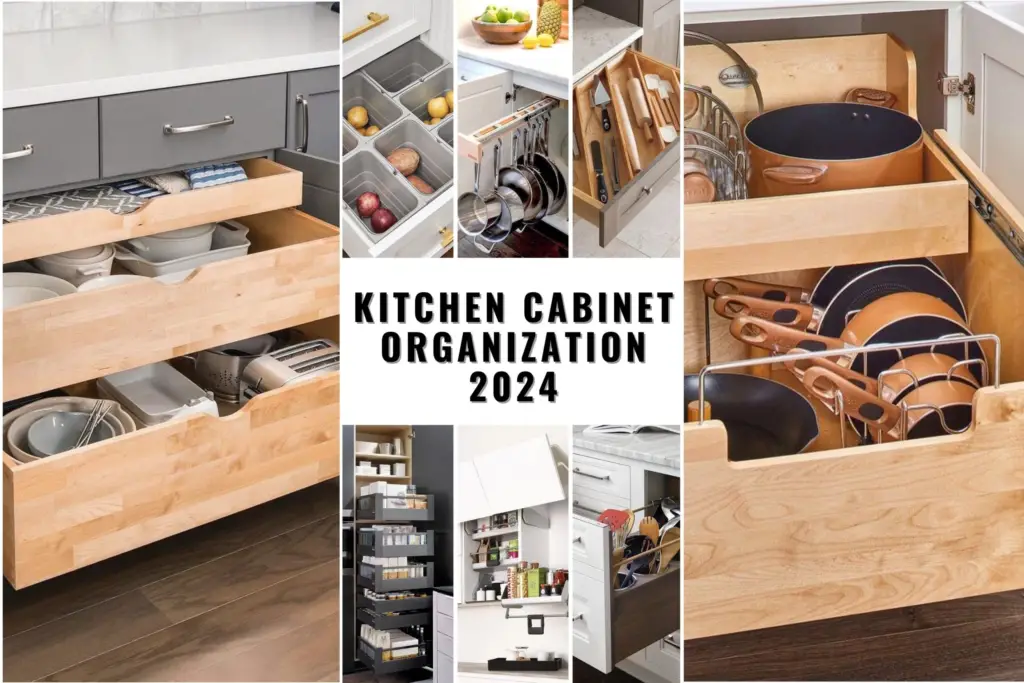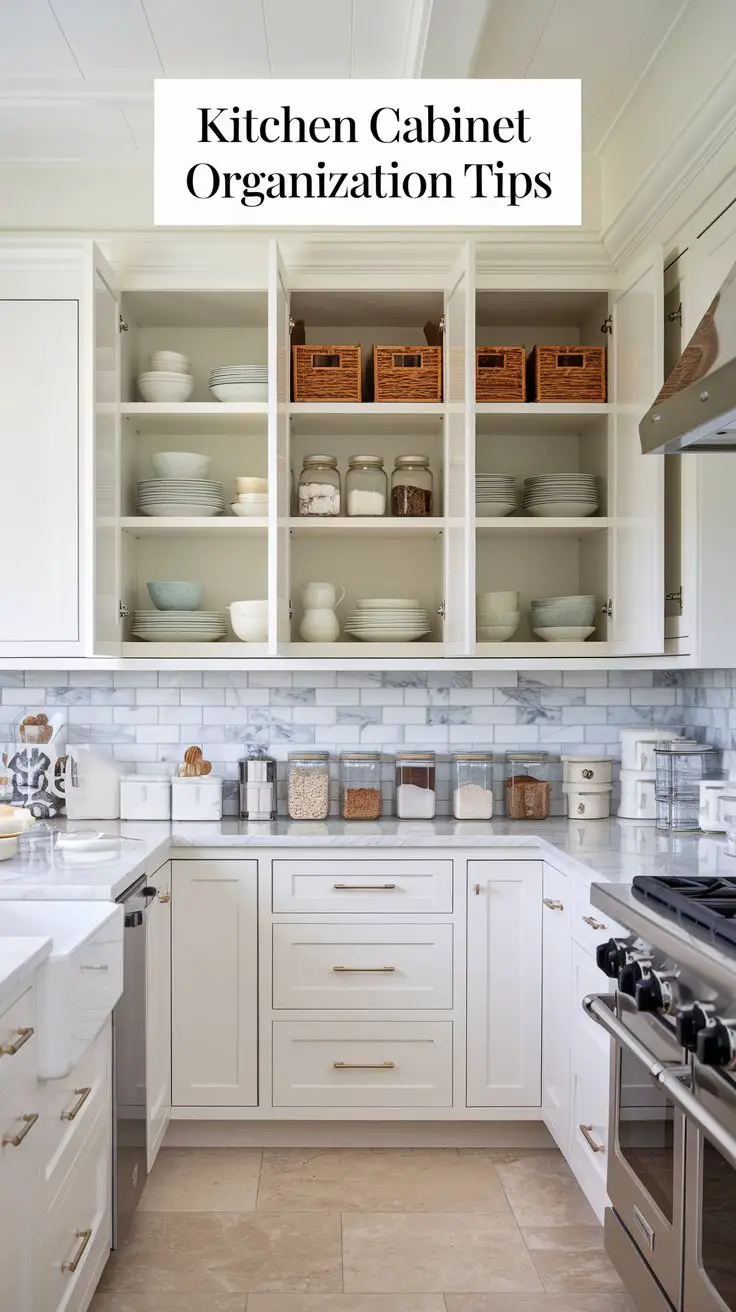
A well-organized kitchen is the cornerstone of a functional household. Maximizing storage space within your kitchen cabinets not only enforces order but also enhances the overall aesthetics. It allows you to operate efficiently, minimizing the frustration of searching for utensils, pots, or pantry items. A clutter-free kitchen cultivates an environment conducive to culinary creativity and ease, a sanctuary where every item has its place, and every space is optimized for utility.

How Kitchen Cabinet Organization Enhances Functionality and Aesthetics
When your kitchen cabinets are meticulously organized, you can quickly access anything you need, which expedites meal preparation and cleanup. Beyond the practicality, an organized kitchen exudes a sense of elegance and calm. The harmony of a well-ordered kitchen reflects in its visual appeal, transforming it from a mere workspace into a welcoming area where form meets function effortlessly.
Overview of Simple and Effective Organization Tips
Effective kitchen cabinet organization encompasses a range of techniques, from utilizing vertical space to incorporating drawer organizers. By employing strategies like adding under-shelf baskets, maximizing corner storage, and decluttering, you can significantly enhance both the efficiency and appearance of your kitchen. These tips provide you with the tools needed to revamp your kitchen layout, leading to optimal storage solutions.
Assessing Your Kitchen Storage Needs
Take Stock of What You Have and What You Use Most
Start by thoroughly inventorying your kitchen items. Identify what you own, what you use on a daily basis, and those items that only serve during special occasions. This step is crucial as it helps you understand the scope of your storage requirements. Remember, it’s easier to organize when you know exactly what you need to accommodate.

How to Prioritize Based on Kitchen Size and Lifestyle
Your kitchen size and personal lifestyle should dictate your storage priorities. A large kitchen might afford the luxury of dedicated spaces for various items, whereas a smaller kitchen would necessitate more strategic planning. Analyze your cooking habits, family size, and frequency of entertaining guests. Tailoring your storage according to these factors ensures a more personalized and efficient kitchen setup.

Understanding the Limitations of Small Kitchen Spaces
Small kitchens come with unique challenges. Space constraints require innovative solutions such as utilizing wall-mounted racks, magnetic strips for knife storage, or compact shelving units. Recognizing these limitations allows you to adopt solutions that maximize every inch of available space, ensuring your kitchen remains functional despite its size.
Decluttering Your Cabinets
Tips for Decluttering Before Organizing
Before you embark on organizing your kitchen cabinets, decluttering is imperative. Remove all items from your cabinets and assess each piece. Consider whether each item deserves a spot in your kitchen based on its utility and frequency of use. This step lays a solid foundation for a more organized space.

Identifying Items to Keep, Donate, or Discard
Sort items into three categories: keep, donate, or discard. Keep essentials that you use regularly. Donate duplicates or items in good condition but not frequently used. Discard broken or expired items. This selective approach not only reduces clutter but also creates room for better organization.
How Decluttering Helps Create More Space
Decluttering fundamentally changes the landscape of your storage space. By eliminating unnecessary items, you liberate precious cabinet real estate, making it easier to store and retrieve the items you actually need. This process results in a more breathable, accessible, and spacious kitchen environment.
Like Us on Facebook!
Using Vertical Space Efficiently
Adding Shelf Risers for Double-Stacked Storage
Shelf risers are ingenious tools that allow you to create double-stacked storage on a single shelf, effectively doubling the available space. Ideal for pantries, these risers enable you to store plates, mugs, or pantry items in a more organized manner, making full use of the vertical space within your cabinets.
Subscribe Us on YouTube!
Utilizing the Tops of Cabinets for Lesser-Used Items
The tops of your kitchen cabinets are perfect for storing items that are not frequently used, such as seasonal bakeware or specialty serving dishes. Utilize decorative baskets or bins to keep these items organized and dust-free, while adding a touch of style to your kitchen décor.
How Hanging Organizers on Cabinet Doors Can Save Space
Hanging organizers mounted on the inside of cabinet doors are excellent for saving space. Use them to store spices, measuring spoons, plastic wrap, or cleaning products. This overlooked space becomes a handy spot for items that need to be easy to grab, yet tucked away out of sight.
Maximizing Corner Cabinet Storage
Lazy Susans for Easy Access to Items in Corner Cabinets
Lazy Susans offer a smart solution for corner cabinets. These rotating trays provide easy access to items stored in hard-to-reach corners, making them perfect for spices, condiments, or canned goods. Incorporating Lazy Susans ensures that every nook of your cabinet is accessible and organized.

Pull-Out Shelves or Drawers for Deep Corner Cabinets
Deep corner cabinets can be challenging, but pull-out shelves or drawers can transform these spaces. These additions allow you to pull items out fully, providing visibility and access to everything stored inside. They are great for storing pots, pans, or cleaning supplies.
Creative Ways to Make Corner Spaces Functional
Be creative with corner spaces. Install custom corner shelving, use swing-out shelves, or integrate custom drawer systems. Such innovations can turn awkward, forgotten corners into functional, practical storage spaces, enhancing the overall utility of your kitchen.
Incorporating Drawer Organizers
How Drawer Organizers Reduce Clutter
Drawer organizers partition your drawers into designated sections, reducing clutter by ensuring every item has a specific place. This system works wonders for keeping utensils, cutlery, and small kitchen gadgets neatly organized, making them much easier to find and use.
Tips for Organizing Cutlery, Utensils, and Other Small Items
When organizing cutlery and utensils, utilize compartments tailored to different sizes and types. Arrange items based on usage frequency; place everyday items in more accessible compartments and specialty tools further back. Keeping similar items grouped also aids in maintaining clarity and order.
Using Adjustable Dividers for Flexibility
Adjustable dividers offer flexibility within your drawers by allowing you to customize the size of each compartment as needed. This adaptability is perfect for accommodating various items, from large cooking tools to small kitchen gadgets, thereby optimizing drawer space use.
Adding Pull-Out Shelves and Drawers
Benefits of Pull-Out Shelves for Easier Access to Deep Cabinets
Pull-out shelves and drawers are game-changers for deep kitchen cabinets. They provide easy access to items stored at the back, reducing the need to rummage through layers of items. This innovation not only saves time but also protects your items from potential damage.
Step-by-Step Guide on Installing Pull-Out Drawers
To install pull-out drawers, start by measuring your cabinet interior. Purchase drawers that fit these dimensions. Mark where the rails will go, ensuring they are level. Secure the rails to the cabinet sides with screws. Slide the drawer onto the rails, testing for smooth operation. Adjust as necessary to ensure a perfect fit.
Best Items to Store in Pull-Out Drawers (Pots, Pans, Cleaning Supplies)
Pull-out drawers are excellent for storing bulky items like pots, pans, and lids. They’re also ideal for organizing cleaning supplies, as their extendable nature provides full visibility and access. This method keeps your kitchen essentials organized and within reach.
Using Clear Bins and Baskets
The Importance of Using Clear Bins to See Contents Easily
Clear bins provide the advantage of visibility, allowing you to see the contents without rummaging through multiple containers. This transparency is particularly beneficial for pantry items, as it enables quick identification and access, making meal prep and inventory management simpler.
Categorizing Pantry Items with Baskets for Easy Access
Utilize baskets to categorize pantry items such as snacks, baking supplies, or canned goods. Grouping similar items together in baskets not only organizes your pantry but also accelerates the process of finding what you need. Label the baskets for added clarity and convenience.
Labeling Containers for a Streamlined, Uniform Look
Labeling containers contributes to a streamlined and uniform appearance in your kitchen. It eliminates guessing games and helps everyone in the household maintain order. Use clear, concise labels that indicate the contents and, if applicable, expiration dates for quick reference.
Door-Mounted Organizers for Extra Storage
Ideas for Using the Inside of Cabinet Doors for Extra Storage
The inside of cabinet doors is often an underutilized space that can be harnessed for additional storage. Install racks or hooks to hold small items like spice jars, cutting boards, or cleaning products. This clever use of space keeps essential items accessible yet out of view, reducing countertop clutter.
Hanging Spice Racks, Measuring Spoons, or Paper Towel Holders on Doors
Hanging spice racks on cabinet doors ensures your spices are within easy reach while cooking. Similarly, hooks for measuring spoons or paper towel holders can streamline your kitchen workflow. These installations make efficient use of space and contribute to a more organized kitchen environment.
Space-Saving Hooks for Pot Lids or Dish Towels
Attach space-saving hooks to the inside of cabinet doors for storing pot lids or dish towels. This solution keeps pot lids organized and easily accessible, freeing up valuable shelf space. Dish towels hung on hooks dry faster and are always within reach when needed.
Organizing Kitchen Cabinet Zones
Zoning Your Kitchen for Efficient Cooking and Storage
Organizing your kitchen into zones streamlines cooking and enhances efficiency. Create specific zones for prepping, cooking, and storage. For instance, set up a baking zone near the oven, a prep zone with easy access to knives and cutting boards, and a storage zone for pantry items and dishes.
Setting Up Specific Areas for Prep, Cooking, and Storage
Define areas in your kitchen dedicated to different tasks. The prep area should include chopping boards, knives, and mixing bowls. The cooking area needs pots, pans, and spices within arm’s reach. The storage area should be well-stocked with pantry items organized by category. This separation helps maintain order and function.
How to Organize Your Cabinets by Usage Frequency
Organize your cabinets based on how frequently you use the items stored within. Place daily-use items such as mugs, plates, and commonly used cookware in easily accessible areas. Items used less frequently, like holiday dishes or specialty bakeware, should be stored in higher or less convenient spots.
Installing Under-Shelf Baskets
How Under-Shelf Baskets Create Additional Storage
Under-shelf baskets are an efficient way to add storage. These baskets attach to existing shelves, providing an additional layer of storage underneath. They’re perfect for holding smaller items like mugs, spices, kitchen towels, or pantry staples. In closets, under-shelf baskets can hold accessories such as scarves, belts, or even small bags. They’re also ideal for office spaces, where they can store notebooks, pens, or other supplies, keeping the desk surface clutter-free. In bathrooms, they can be used for storing toiletries, hand towels, or cleaning products. Under-shelf baskets are versatile, easy to install, and help maximize space without the need for bulky furniture or additional shelving units.




















